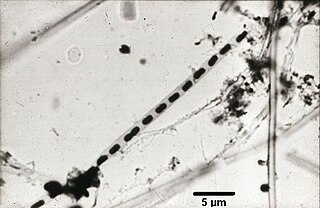
The Comamonadaceae are a family of the Betaproteobacteria. Like all Pseudomonadota, they are Gram-negative. They are aerobic and most of the species are motile via flagella. The cells are curved rod-shaped.
The Hydrogenophilaceae are a family of the class Hydrogenophilalia in the phylum Pseudomonadota ("Proteobacteria"), with two genera – Hydrogenophilus and Tepidiphilus. Like all Pseudomonadota, they are Gram-negative. All known species are thermophilic, growing around 50 °C, and use molecular hydrogen or organic molecules as their source of electrons to support growth; some species are autotrophs.

The Alteromonadales are an order of Pseudomonadota. Although they have been treated as a single family, the Alteromonadaceae, they were divided into eight by Ivanova et al. in 2004. The cells are straight or curved rods. They are motile by the use of a single flagellum. Most of the species are marine.
The Alteromonadaceae are a family of Pseudomonadota. They are now one of several families in the order Alteromonadales, including Alteromonas and its closest relatives. Species of this family are mostly rod-like shaped and motile by using one polar flagellum.
The Ectothiorhodospiraceae are a family of purple sulfur bacteria, distinguished by producing sulfur globules outside of their cells. The cells are rod-shaped, vibrioid, or spirilla, and they are able to move using flagella. In general, they are marine and prefer anaerobic conditions. Ectothiorhodospiraceae are a vibrio bacteria that require salty living conditions to survive and grow: classifying them as slightly halophilic. Like all purple sulfur bacteria, they are capable of photosynthesis. To complete this energy process, Sulfur compounds are used as electron donors for carbon fixation in the pentose phosphate pathway. This elemental sulfur accumulates outside of the cells.
Phocoenobacter is a Gram-negative and rod-shaped genus of bacteria from the family of Pasteurellaceae with one known species. Phocoenobacter uteri has been isolated from the uterus of a harbour porpoise from Inverness in Scotland.
Desulforhopalus is a Gram-negative, strictly anaerobic, and non-motile genus of bacteria from the family of Desulfobulbaceae.
Nitratifractor is a genus of bacteria from the order Campylobacterales, with one known species.
Halorhodospira is a Gram-negative genus of bacteria from the family of Ectothiorhodospiraceae. Halorhodospira bacteria occur in hypersaline and extreme saline habitats.
Halochromatium is a Gram-positive and motile genus of bacteria from the family of Chromatiaceae. Halochromatium bacteria occur in microbial mats from hypersaline habitates.
Isochromatium is a Gram-negative, obligately phototrophic and strictly anaerobic genus of bacteria from the family of Chromatiaceae with one known species.
Lamprobacter is a Gram-negative, rod-shaped and motile genus of bacteria from the family of Chromatiaceae with one known species. The habitat of Lamprobacter bacteria is hydrogen sulfide-containing mud and saline water.
Thiococcus is a Gram-negative, non‐motile, obligately phototrophic and strictly anaerobic genus of bacteria from the family of Chromatiaceae with one known species. Thiococcus pfennigii was first isolated from salt marshes.
Thiohalocapsa is a Gram-negative and non-motile genus of bacteria from the family of Chromatiaceae.
Thiorhodococcus is a Gram-negative genus of bacteria from the family of Chromatiaceae.
Thiorhodovibrio is a Gram-negative genus of bacteria from the family of Chromatiaceae.
Thioreductor is a Gram-negative, mesophilic, hydrogen-oxidizing, sulfur-reducing and motile genus of bacteria from the phylum Campylobacterota with one known species. Thioreductor micantisoli has been isolated from hydrothermal sediments from the Iheya North from the Mid-Okinawa Trough in Japan.
Oceanimonas baumannii is a Gram-negative and motile bacterium from the genus of Oceanimonas which has been isolated from estuarine mud from the River Wear in England.
Tistrella mobilis is a Gram-negative, strictly aerobic, rod-shaped and highly motile bacterium from the genus of Tistrella which has been isolated from wastewater in Thailand. Tistrella mobilis produces didemnins.
Alterococcus agarolyticus is a Gram-negative, facultatively anaerobic, halophilic and thermophilic bacterium from the genus of Alterococcus.

